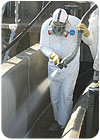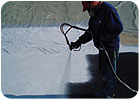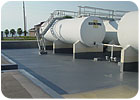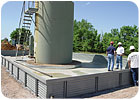
A finisher applies a poyurea spray coating to an AST. Photo courtesy of GlasCraft, Inc.
The Code of Federal Regulations (CFR) 40, Protection of the Environment, requires by federal law that all hazardous wastes or constituents be positively contained. In 1987, the Environmental Protection Agency (EPA) passed a regulation under CFR 40 requiring a secondary means of containing spilled materials that include hazardous chemicals (Section 265.190-265.193, 40 CFR); however, this regulation is really only just now starting to be enforced.
Two deadlines are rapidly approaching, one for the secondary containment of underground storage tanks (USTs) and the other for aboveground storage tanks (ASTs):
- December 31, 2009 – Corrosion-protected single-wall USTs and small-diameter piping in contact with the soil must have secondary containment.
- January 1, 2010 – Single-wall, field-erected ASTs must have secondary containment beneath the tank, and single-wall bulk product piping in contact with the soil must have secondary containment unless deferred by an API 570 Integrity Assessment.
Many USTs and ASTs are made of concrete. The regulation notes that concrete is porous, and that the most reliable means of secondary containment on concrete is with a liquid-applied monolithic polymer membrane. One polymer membrane that meets the new requirements is polyurea spray elastomer technology.
Polyurea Spray Technology
Polyurea spray technology is a plural-component, fast-set elastomeric membrane system that provides for a monolithic, impervious layer. Various formulated systems address the numerous requirements related to secondary containment, including adhesion to the various substrates commonly encountered in these containment areas. For containment areas where solid substrates are not present, geomembranes can be used with an applied layer of a polyurea system incorporating low shrinkage characteristics designed for the area.The fast set time of the polyurea spray technology allows for a rapid return to service of the area in a variety of ambient conditions, including cold weather. The polyurea systems also remain flexible at low temperatures, thus eliminating cracking issues found in other liquid applied coatings and sheet-good installed membranes.
Many tanks and piping areas may be prone to leakage. However, it has been shown that most leakages found in these areas are actually due to overfilling of the storage tanks, possibly a result of faulty equipment or operator error.
The polyurea spray elastomer technology has been evaluated under the Florida Department of Environmental Quality (DEQ) requirements for secondary containment liner systems. The technology has passed this testing and is classified as an acceptable secondary containment lining material.

For containment areas where solid substrates are not present, geomembranes can be used with an applied layer of a polyurea system. Photo courtesy of GlasCraft, Inc.
Polyurea Installations
Fully aware of the impending environmental regulations, the U.S. military has used the polyurea technology successfully for lining various fuel storage containment areas. As a matter of fact, this technology currently is being specified by engineering contract firms working with the U.S. Air Force and U.S. Navy. Work includes applications at Patrick Air Force Base, Cape Canaveral Air Force Station, AUTEC U.S. Navy Base and a variety of fuel storage areas for municipal airports (see the sidebar at right). Most of these areas have an existing epoxy paint system applied to the concrete. The epoxy has cracked with the movement of the concrete over time, thus allowing for a breach in the containment area and potential environmental issues. The polyurea technology, as an elastomeric system, bridges those cracks and yields a superior containment lining material.For existing asphalt, earthen berm or gravel containment areas, the polyurea system is applied on top of a geotextile membrane, as noted previously. The polyurea system bonds to the geotextile membrane, as well as the existing tanks, pipe pentrations and sump areas, and provides for a seamless installation without the use of mechanical fastening, as is required with sheet-good installed material. Many such applications have been successfully completed at major fuel, oil and chemical storage facilities. The polyurea systems used in these cases is specifically formulated to provide for a low cure shrinkage as applied over the unsupported geotextile membrane. Recent work in North America includes projects that are in the 300,000 to 450,000 ft2 (28,000 to 42,000 m2) range. These large projects typically are completed within one month using application-trained installation crews.
With the resurgence of oil and gas exploration in the U.S., containment areas for the fractionation fluid are required at each drilling site. For this work, a designed containment area is prepared, metal support walls are constructed, and a designed polyurea spray system is applied over a geotextile fabric. The polyurea system bonds to the wall area and geotextile fabric to provide for a seamless, leak-free area. The storage tanks are then set within the area and piped in the same day as the liner system installation.
A Compliant Solution
For any companies or organizations that deal with hazardous materials, the new secondary containment rules are looming on the horizon. With polyurea spray elastomer technology, companies can meet the new regulations with a durable coating solution, without incurring excessive downtime.Author’s note: Thanks to Steve DeReu at GlasCraft, Inc. (www.glascraft.com) for his assistance with this article.

Case Study: Cape Canaveral Air Force Station
Cape Canaveral Air Force Station (CCAFS) is the East Coast space launch facility of the U.S. Department of Defense. Located on Cape Canaveral, Brevard County in Florida, it depends on Patrick Air Force Base, home of the 45th Space Wing, and is adjacent to the John F. Kennedy Space Center.The 11,000 ft2fuel truck pad area was in need of an improved liner system. The existing concrete pad was experiencing severe cracking, and there were concerns over potential spills of fuel seeping into the groundwater. CCAFS chose a polyurea system (PV 350 supplied by PolyVers International) due to its excellent performance history in similar application areas, flexibility, toughness for heavy traffic and speed of installation.
Installation of the polyurea spray elastomer technology took place in December 2007. The concrete area was pressure washed using a hot aqueous solution of BioSolve® (supplied by The Westford Chemical Corp.) to remove any contaminants and rinsed. The prepared concrete had a profile of CSP 4 to 5, which would provide for excellent bonding of the applied liner system.
The complete area was primed with a proprietary polyurethane primer system for adhesion enhancement and reduction/elimination of outgassing in the concrete area. The PV 350 polyurea system was then applied at a minimum average thickness of 100 mils (2.5 mm). A 1/4-inch (6.35 mm) saw cut joint was used to assist in terminating the PV 350 system around the perimeter area. The area was prepared one day and followed by primer and application of the PV 350 system during the next few days. A finish stipple texture was provided to aid in slip resistance
The PV 350 system was applied using a GUSMER® H-25/25 unit fitted with a GlasCraft® Probler® P2 spray gun with an “02” chamber and tip to provide a controlled output and spray pattern at a 2000 psi (138 bar) processing pressure.

Case Study: BBL Falcon Industries
BBL Falcon Industries has taken full advantage of the resurgence of the oil drilling activities in Texas, Oklahoma and New Mexico. In field work, secondary containment areas are constructed prior to the placement of condensate tanks. These areas, typically measuring 24 x 56 x 2.3 ft, are fabricated on-site. FSS-45DC polyurea system from VersaFlex, Inc. is applied over the geotextile and on the perimeter walls, as opposed to the sheet-good liner systems that have seams and are susceptible to leaks. The FSS-45DC is applied at a minimum average 80 mils (2 mm) on the 12-oz geotextile fabric.BBL Falcon Industries has a patent-pending procedure for rehabilitating existing tank drilling sites, as well as new installation areas. Designed areas are cleaned and leveled, the metal perimeter installed and the geotextile fabric laid. The FSS-45DC is applied up and onto the geotextile and perimeter wall area. Once the material has been laid in place and sprayed with the FSS-45DC, the tanks and piping are set in place.
The FSS-45DC system is applied using a GlasCraft MH-III proportioning unit fitted with a GlasCraft Probler P2 spray gun. An “02” chamber is used with an “01” insert tip to provide a controlled output and spray pattern at a 2000 psi (138 bar) processing pressure.

Report Abusive Comment